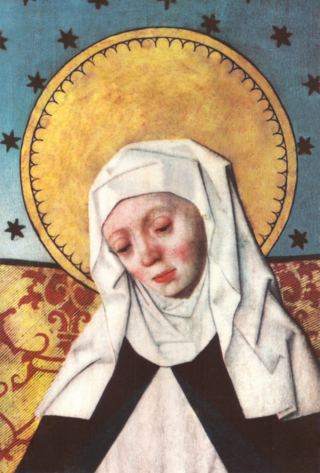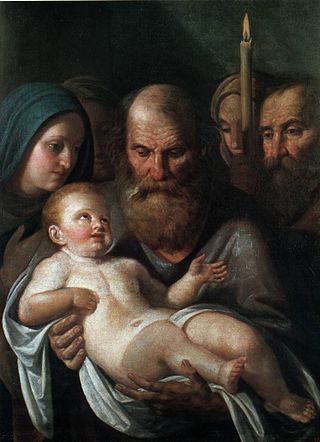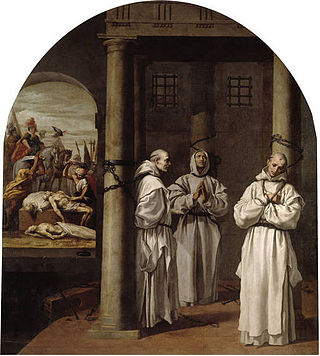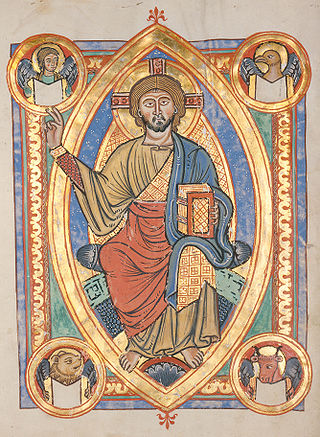Related Research Articles

Palm Sunday is the Christian moveable feast that falls on the Sunday before Easter. The feast commemorates Christ's triumphal entry into Jerusalem, an event mentioned in each of the four canonical Gospels. Its name originates from the palm branches waved by the crowd to greet and honor Jesus as he entered the city. Palm Sunday marks the first day of Holy Week; in Western Christianity, this is the beginning of the last week of the solemn season of Lent, preceding Eastertide, while in Eastern Christianity, Holy Week commences after the conclusion of Great Lent.

The Carthusians, also known as the Order of Carthusians, are a Latin enclosed religious order of the Catholic Church. The order was founded by Bruno of Cologne in 1084 and includes both monks and nuns. The order has its own rule, called the Statutes, and their life combines both eremitical and cenobitic monasticism. The motto of the Carthusians is Stat crux dum volvitur orbis, Latin for "The Cross is steady while the world turns". The Carthusians retain a unique form of liturgy known as the Carthusian Rite.

Bridget of Sweden, OSsS born as Birgitta Birgersdotter, also Birgitta of Vadstena, was a Swedish widow, mystic, saint, and the founder of the Bridgettines. Outside Sweden, she was also known as the Princess of Nericia and was the mother of Catherine of Vadstena.

Peter of Verona, also known as Saint Peter Martyr and Saint Peter of Verona, was a 13th-century Italian Catholic priest. He was a Dominican friar and a celebrated preacher. He served as Inquisitor in Lombardy, was killed by an assassin, and was canonized as a Catholic saint 11 months after his death, making this the fastest canonization in history.

The Feast of Corpus Christi, also known as the Solemnity of the Most Holy Body and Blood of Christ, is a Christian liturgical solemnity celebrating the Real Presence of the Body and Blood, Soul and Divinity of Jesus in the elements of the Eucharist; it is observed by the Latin Church, in addition to certain Western Orthodox, Lutheran, and Anglican churches. Two months earlier, the institution of the Eucharist at the Last Supper is observed on Maundy Thursday in a sombre atmosphere leading to Good Friday. The liturgy on that day also commemorates Christ's washing of the disciples' feet, the institution of the priesthood, and the agony in the Garden of Gethsemane.

Nicholas of Tolentino (Latin: S. Nicolaus de Tolentino,, known as the Patron of Holy Souls, was an Italian saint and mystic. He is particularly invoked as an advocate for the souls in Purgatory, especially during Lent and the month of November. In many Augustinian churches, there are weekly devotions to St. Nicholas on behalf of the suffering souls. November 2, All Souls' Day, holds special significance for the devotees of St. Nicholas of Tolentino.

Bruno of Cologne, venerated as Saint Bruno, was the founder of the Carthusian Order. He personally founded the order's first two communities. He was a celebrated teacher at Reims, and a close advisor of his former pupil, Pope Urban II. His feast day is 6 October.

The Presentation of Jesus is an early episode in the life of Jesus Christ, describing his presentation at the Temple in Jerusalem. It is celebrated by many churches 40 days after Christmas on Candlemas, or the "Feast of the Presentation of Jesus". The episode is described in chapter 2 of the Gospel of Luke in the New Testament. Within the account, "Luke's narration of the Presentation in the Temple combines the purification rite with the Jewish ceremony of the redemption of the firstborn ."

The Forty Martyrs of England and Wales or Cuthbert Mayne and Thirty-Nine Companion Martyrs are a group of Catholic, lay and religious, men and women, executed between 1535 and 1679 for treason and related offences under various laws enacted by Parliament during the English Reformation. The individuals listed range from Carthusian monks who in 1535 declined to accept Henry VIII's Act of Supremacy, to seminary priests who were caught up in the alleged Popish Plot against Charles II in 1679. Many were sentenced to death at show trials, or with no trial at all.

Benedict Joseph Labre, TOSF was a French Franciscan tertiary, and Catholic saint. Labre was from a well to do family near Arras, France. After attempting a monastic lifestyle, he opted instead for the life of a pilgrim. He traveled to most of the major shrines of Europe, subsisting by begging. Labre is patron saint of the homeless.

Hermann Joseph, was a German Premonstratensian canon regular and mystic. Never formally canonized, in 1958 his status as a saint of the Roman Catholic Church was formally recognized by Pope Pius XII.

Kuriakose Elias Chavara, CMI was an Indian Syro-Malabar Catholic priest, religious, philosopher and social reformer. He is the first canonised Catholic male saint of Indian origin and a member of the Syro-Malabar Church, an Eastern Catholic church. He was the co-founder and first Prior General of the first congregation for men in the Syro-Malabar Church, now known as the Carmelites of Mary Immaculate (CMI), and of a similar one for women, the Congregation of the Mother of Carmel (CMC). He was a pioneer in many fields.

Simeon at the Temple is the "just and devout" man of Jerusalem who, according to Luke 2:25–35, met Mary, Joseph, and Jesus as they entered the Temple to fulfill the requirements of the Law of Moses on the 40th day from Jesus' birth, i. e. the presentation of Jesus at the Temple.

The Carthusian Martyrs of London were the monks of the London Charterhouse, the monastery of the Carthusian Order in the City of London who were put to death by the English state in a period lasting from the 4 May 1535 until the 20 September 1537. The method of execution was hanging, disembowelling while still alive and then quartering. Others were imprisoned and left to starve to death. The group also includes two monks who were brought to that house from the Charterhouses of Beauvale and Axholme and similarly dealt with. The total was 18 men, all of whom have been formally recognized by the Catholic Church as martyrs.

The Certosa di Pavia is a monastery and complex in Lombardy, Northern Italy, situated near a small town of the same name in the Province of Pavia, 8 km (5.0 mi) north of Pavia. Built in 1396–1495, it was once located on the border of a large hunting park belonging to the Visconti family of Milan, of which today only scattered parts remain. It is one of the largest monasteries in Italy.
A Catholic order liturgical rite is a variant of a Catholic liturgical rite distinct from the typical ones, such as the Roman Rite, but instead specific to a certain Catholic religious order.

The Solemnity of Mary, the Holy Mother of God is a feast day of the Blessed Virgin Mary under the aspect of her motherhood of Jesus Christ, whom She had circumcised on the eighth day after His birth according to Levitical Law. Christians see Him as the Lord and Son of God.

Roseline or Rossolina de Villeneuve was a French Carthusian nun. She is regarded as a saint in the Roman Catholic Church.

Joachim was, according to Christian tradition, the husband of Saint Anne, the father of Mary, the mother of Jesus, and the maternal grandfather of Jesus.

The Roman Catholic tradition includes a number of devotions to Jesus Christ. Like all Catholic devotions, these prayer forms are not part of the official public liturgy of the Church but are based on the popular spiritual practices of Roman Catholics. Many are officially approved by the Holy See as suitable for spiritual growth but not necessary for salvation.
References
- 1 2 William of Fenoli: http://www.angelfire.com/nv2/monastic2/carthusian/william.html
- ↑ Carthusian Order: http://www.angelfire.com/nv2/monastic2/carthusian/home.html
- ↑ Carthusian history: Le Couteulx, Annales Ordinis Cartusiensis vol. iii, pp. 293-302.
- ↑ Papal records: Analecta Juris Pontificii, vol. v, 1861, cc. 129-134.
- ↑ Miracles:http://www.lngplants.com/Miracles_1200.html#1205_Blessed_William_of_Fenoli
- ↑ Medallion by Giovanni Scrivo (1868-1933), kept at the Museo della Certosa - C. da Certosa, 1 - 89822 Serra San Bruno (VV) - Italy. Web address: http://www.museo.certosini.info/.
- ↑ Feast Day: http://www.saintpatrickdc.org/ss/1219.shtml